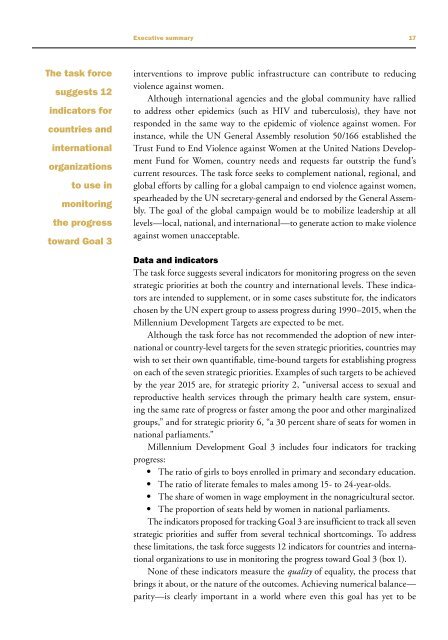Taking action: achieving gender equality and empowering women
Taking action: achieving gender equality and empowering women
Taking action: achieving gender equality and empowering women
Create successful ePaper yourself
Turn your PDF publications into a flip-book with our unique Google optimized e-Paper software.
Executive summary<br />
17<br />
The task force<br />
suggests 12<br />
indicators for<br />
countries <strong>and</strong><br />
international<br />
organizations<br />
to use in<br />
monitoring<br />
the progress<br />
toward Goal 3<br />
interventions to improve public infrastructure can contribute to reducing<br />
violence against <strong>women</strong>.<br />
Although international agencies <strong>and</strong> the global community have rallied<br />
to address other epidemics (such as HIV <strong>and</strong> tuberculosis), they have not<br />
responded in the same way to the epidemic of violence against <strong>women</strong>. For<br />
instance, while the UN General Assembly resolution 50/166 established the<br />
Trust Fund to End Violence against Women at the United Nations Development<br />
Fund for Women, country needs <strong>and</strong> requests far outstrip the fund’s<br />
current resources. The task force seeks to complement national, regional, <strong>and</strong><br />
global efforts by calling for a global campaign to end violence against <strong>women</strong>,<br />
spearheaded by the UN secretary-general <strong>and</strong> endorsed by the General Assembly.<br />
The goal of the global campaign would be to mobilize leadership at all<br />
levels—local, national, <strong>and</strong> international—to generate <strong>action</strong> to make violence<br />
against <strong>women</strong> unacceptable.<br />
Data <strong>and</strong> indicators<br />
The task force suggests several indicators for monitoring progress on the seven<br />
strategic priorities at both the country <strong>and</strong> international levels. These indicators<br />
are intended to supplement, or in some cases substitute for, the indicators<br />
chosen by the UN expert group to assess progress during 1990–2015, when the<br />
Millennium Development Targets are expected to be met.<br />
Although the task force has not recommended the adoption of new international<br />
or country-level targets for the seven strategic priorities, countries may<br />
wish to set their own quantifiable, time-bound targets for establishing progress<br />
on each of the seven strategic priorities. Examples of such targets to be achieved<br />
by the year 2015 are, for strategic priority 2, “universal access to sexual <strong>and</strong><br />
reproductive health services through the primary health care system, ensuring<br />
the same rate of progress or faster among the poor <strong>and</strong> other marginalized<br />
groups,” <strong>and</strong> for strategic priority 6, “a 30 percent share of seats for <strong>women</strong> in<br />
national parliaments.”<br />
Millennium Development Goal 3 includes four indicators for tracking<br />
progress:<br />
• The ratio of girls to boys enrolled in primary <strong>and</strong> secondary education.<br />
• The ratio of literate females to males among 15- to 24-year-olds.<br />
• The share of <strong>women</strong> in wage employment in the nonagricultural sector.<br />
• The proportion of seats held by <strong>women</strong> in national parliaments.<br />
The indicators proposed for tracking Goal 3 are insufficient to track all seven<br />
strategic priorities <strong>and</strong> suffer from several technical shortcomings. To address<br />
these limitations, the task force suggests 12 indicators for countries <strong>and</strong> international<br />
organizations to use in monitoring the progress toward Goal 3 (box 1).<br />
None of these indicators measure the quality of <strong>equality</strong>, the process that<br />
brings it about, or the nature of the outcomes. Achieving numerical balance—<br />
parity—is clearly important in a world where even this goal has yet to be

















